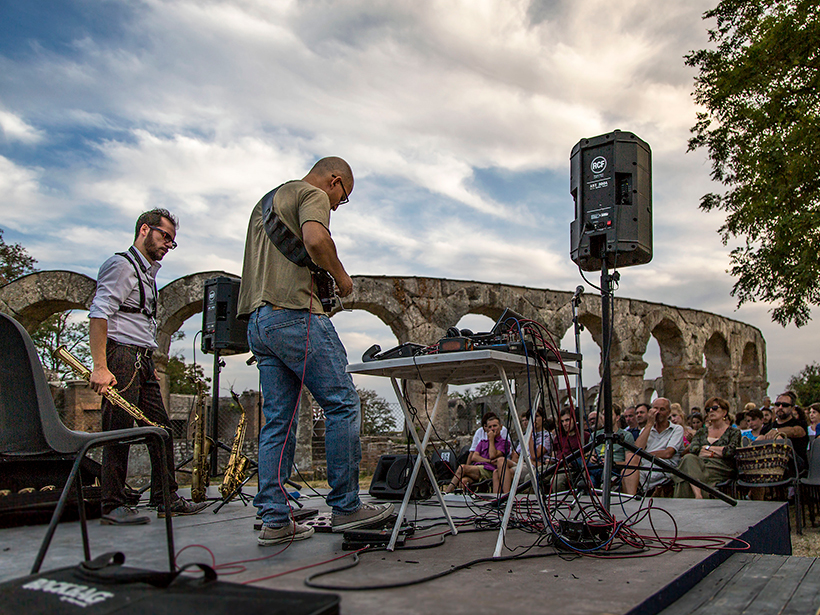A musician-scientist team is giving a whole new meaning to the term “rock music.”
Geophysicist Antonio Menghini and musician Stefano Pontani have created a method of transforming geophysical data into jazzy, ephemeral refrains as part of their EMusic project. The group teams up with musicians on saxophone, guitar, and other instruments to bring geophysical soundscapes to life at conferences and outdoor venues across Europe.
Sonification projects are part of a growing interest by scientists to enhance and clarify scientific information. A four-part string quartet performance about warming temperatures from climate change and an effort at Columbia’s Lamont-Doherty Earth Observatory to convert seismic wave data from earthquakes into sounds are just two examples of scientists turning to music to communicate their research.
EMusic aims at helping people understand a particular landscape’s geology through sound and live performances. They transform electromagnetic measurements of the subsurface into musical notes, an effect that Menghini said creates a “natural soundtrack of the landscape.” The data come from measurements that Menghini and his team have taken on the ground and by air, and they show the resistivity of a material, revealing the composition of layers and structural features like dikes and faults. They then perform this music to live audiences, in some cases at the exact location where the data were taken.
Eos selected a few of EMusic’s videos to dive into Earth’s soundscape. Sit back, relax, and listen to the layers of Earth pass you by.
How to Listen to EMusic

First, a primer on how EMusic chooses its notes: Each note from the geophysical data represents the resistivity of the material below. The EMusic team then normalizes the readings and applies a routine to fit them within a musical scale. This video shows how the electromagnetic measurements are taken and features the earthly vibrations of granite, greenstone, aquifer-regolith, and gold.
What Lies Beneath an Ancient Theater?

At a concert performed in the ruins of an ancient Roman theater of Ferentium (modern Ferento) in central Italy in 2017, EMusic plays the eerie tones of its electromagnetic readings from below the theater for the first half of the video. At around 7 minutes into the piece, a saxophone joins the refrain. Menghini calls this a “natural jam session, where the Earth is the band leader.”
The Beat of the Diatomites

In the third installment of the five-part Ferentium concert, this composition reveals the sounds of a layer of diatomite, a porous sedimentary rock packed with skeletal remains, that sits 30 meters below the surface. Menghini writes that listeners can ponder the ancient setting that gave rise to this layer, characterized by “quiet lagoons and swamps, where the African fauna (elephants, lions, tigers) lived in the past.”
Sounds from Around the World

In an excerpt from a concert at Tuscia University in Viterbo, Italy, in 2018, electromagnetic data blend with saxophone, electric guitar, and electronics to give a tour of geologic sites in Canada, Russia, Sierra Leone, and Italy.
Flying Through an African Greenstone Belt

Finally, in one tune from airborne data taken in Sierra Leone, the viewer is launched into a rendering of the landscape. Fly along as we travel deeper into Earth and musical notes ring out as the composition changes. Colors of strata underground represent the resistivity of the material, with warm tones showing less resistivity and cool tones showing more resistive layers.
Jam Session with Mount Vesuvius
Where will EMusic go next? This September, EMusic is slated to perform from the rim of Mount Vesuvius, the volcano that once destroyed the Roman cities of Pompeii and Herculaneum. The concert will begin with the scientists first collecting electromagnetic data, which Menghini will see for the first time along with the audience. After the band converts the data into notes, the audience will hear an auditory tour of what’s below their feet, with jazz musicians mingling tones with Earth’s geologic melody.
—Jenessa Duncombe (@jrdscience), News Writing and Production Fellow
Citation:
Duncombe, J. (2019), Rock on with a group that makes music from geophysical data, Eos, 100, https://doi.org/10.1029/2019EO126807. Published on 28 June 2019.
Text © 2019. AGU. CC BY-NC-ND 3.0
Except where otherwise noted, images are subject to copyright. Any reuse without express permission from the copyright owner is prohibited.
Text © 2019. AGU. CC BY-NC-ND 3.0
Except where otherwise noted, images are subject to copyright. Any reuse without express permission from the copyright owner is prohibited.

